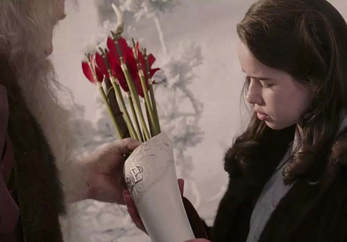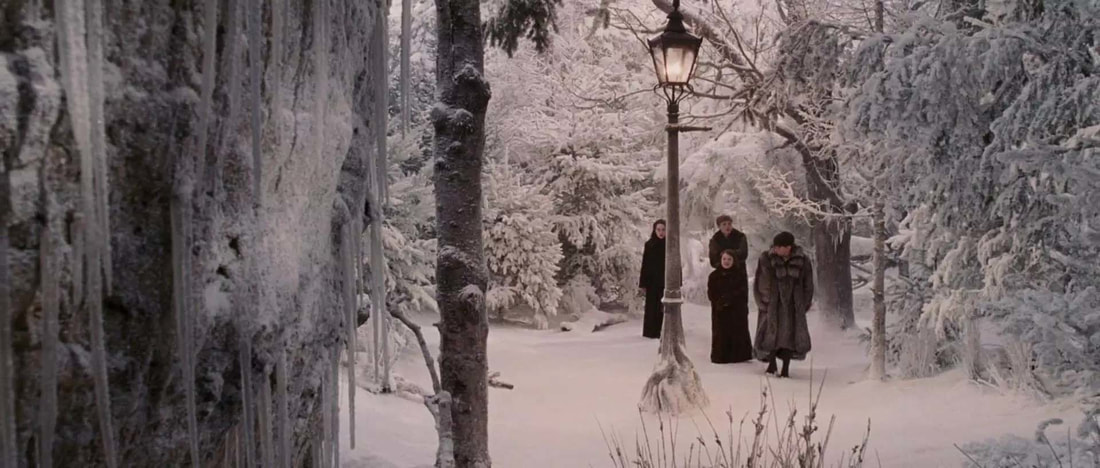|
Christmas is fast approaching and the mad rush to purchase last-minute gifts is in full swing. The season brings with it plenty of sweets, colourful lights, and crowded department stores. For those of you in more northern climes, chances are you’ve been trekking through the snow and ice to do your holiday errands. And finally, the big moment will arrive. You give the gifts, Santa Claus gets the credit, and everybody sits down to eat too much Christmas ham, or your poultry of choice. But believe it or not, that isn’t the only way to celebrate Christmas. They do it a little differently, for example, in Narnia. When we first encounter Narnia in The Lion, the Witch and the Wardrobe it looks like a snow-laden wonderland of sorts. It’s kind of magical, really. But as Mr. Tumnus the faun soon reveals, there is apparently something sinister behind the beautiful quiet of the falling snowflakes. He tells Lucy that the White Witch "has got all Narnia under her thumb. It’s she that makes it always winter. Always winter and never Christmas; think of that!" Sounds horrible. But think of all the time you’d save not having to scour the aisles for stocking stuffers. 
If you remember the story, the Narnians do get to have Christmas eventually. As Peter, Susan, and Lucy Pevensie follow Mr. and Mrs. Beaver through the snow, hoping to escape from the White Witch, they hear the sound of an approaching sledge and its jingling bells. Who else could it be but the witch herself, hoping to catch them before they reach Aslan’s army? But it isn’t. As C.S. Lewis describes the scene, "on the sledge sat a person everyone knew the moment they set eyes on him. He was a huge man in a bright red robe (bright as hollyberries) with a hood that had fur inside it and a great white beard that fell like a foamy waterfall over his chest." Father Christmas himself.
Father Christmas provides the Pevensie children and the beavers with gifts, including a piping hot breakfast, and then whisks away in his sledge before anyone can ask the question: just what is the character Father Christmas doing in a fantasy world? It’s worth noting that the tradition of Santa Claus began as distinct from that of Father Christmas, but the two characters have been combined in recent times. Whereas Santa Claus has developed into a popular American icon, Father Christmas comes from English folklore. Think of the moment in Charles Dickens’ A Christmas Carol when the jolly Ghost of Christmas Present appears, providing a bountiful feast, and you’ll get the idea.

Father Christmas appears to be straight out of our world, with one striking difference. He doesn’t offer the three Pevensies toy trains and stuffed bears. Rather, he arms them with a sword and shield, a bow and arrows, a magical horn, a healing cordial, and a dagger. As Father Christmas remarks, "they are tools not toys. The time to use them is perhaps near at hand. Bear them well." I don’t know about you, but suddenly I’m liking the Narnian version of Christmas. These gifts are serious. We may not pick up swords to fight the kinds of battles they do in Narnia, but even we have our own battles to wage. What could have been a dispensable scene actually moves the story along nicely. It is a moment of transition for Peter, Susan, and Lucy. They better understand the path before them and begin to step into their more mature roles.
But back to the pressing question. What is Father Christmas doing in Narnia in the first place? Talking beavers are one thing, but Santa Claus? That’s a little much. Now if you believed in Father Christmas, presumably you wouldn’t be asking this question. If the lion Aslan wants to bring four children from England into Narnia, why shouldn’t he be allowed to bring Father Christmas as well? But let’s assume you don’t believe the man exists. What then? Well, in our world we have stories about talking animals, but you don’t often meet them. In Narnia, though, you can. The same would appear to be the case for Father Christmas. Narnia seems to be a land where our stories and myths are realized in the flesh. Still, you might insist Father Christmas simply does not fit. It’s like he belongs in a different story. And you’d be in good company. Lewis’s friends and fellow authors Roger Lancelyn Green and J.R.R. Tolkien both objected to Father Christmas’s appearance in The Lion, the Witch and the Wardrobe. Tolkien famously believed Lewis should have kept to a single mythic tradition instead of drawing on a whole range of mythologies, mixing fauns and nymphs together with unicorns, talking mice, and marsh-wiggles. Could there be a reason Lewis rejected their advice? 
One possible response is that, depending how you look at it, Father Christmas may fit the story after all. In his book Planet Narnia, Michael Ward proposes that Lewis planned for each of the books in The Chronicles of Narnia to correspond to one of the seven medieval heavenly bodies. According to Ward’s thesis, the atmosphere of The Lion, the Witch and the Wardrobe is enflamed by Jupiter—meaning both the planet and the Roman god. Jupiter is characterized by joviality, cheer, festiveness, and kingly generosity. These qualities permeate the text and Father Christmas embodies them all. Who better to join the Narnians' celebrations than Father Christmas himself?
Lewis could have invented a Narnian version of Father Christmas. But instead he decided to import the man ready-made into his fantasy world, producing a certain effect on his readers. Father Christmas is familiar to us and his appearance here is one of our first clues that the Narnian story is bigger than it first appears. Our worlds are not as divided as they might seem. We learn later that Aslan claims to have the power to transcend both worlds and to be just as present in ours as he is in Narnia. What are the implications? I personally love the idea that Aslan may have servants everywhere, sending them wherever he pleases. Father Christmas is just one of Aslan’s servants who is allowed to go back and forth between the worlds.
If Father Christmas had offered Peter a couple of candy canes and a LEGO set, now that would have been out of place. But instead the Pevensies receive weapons for their adventure. Whether the children make good use of their weapons is an interesting question and is perhaps best left for a future blog post. What could have been a trivial detour with Father Christmas is transformed into an arming scene reminiscent of epic poetry. Rather than reinforcing childishness it becomes a moment to show Peter, Susan, and Lucy what children are sometimes called to do, and highlights their status as servants of Aslan.
And speaking of Narnia’s king, this scene is doubly important because it confirms that Aslan really is on the move. With Father Christmas’s arrival we know that the witch’s spell is breaking. Aslan is drawing near. Whereas before Narnia was plagued by fear—the fear of watchful eyes and spying trees—now open celebration becomes possible. Narnia’s spirit is revived. For the Pevensies, Christmas is a time of refreshment and also of preparation for the fight ahead. In our world we can miss out on one or both. In a holiday season beset by stress and busyness, we can lose sight of the joy of the season. We need to make time for stillness, for relaxation, or it won't happen. We need time to enjoy Father Christmas’s bountiful feast. And rather than using the holiday’s frivolity as an excuse to blind ourselves to the trouble in the world, it should refocus our attention on what’s important—what we fight for. Perhaps that’s what we should think of when we remember Christmas in Narnia.
Comments
|
David Raphael HilderJoin the conversation as we explore the best there is in fantasy, sci-fi, adventure, and of course, the classics Archives
December 2020
Categories
All
|


